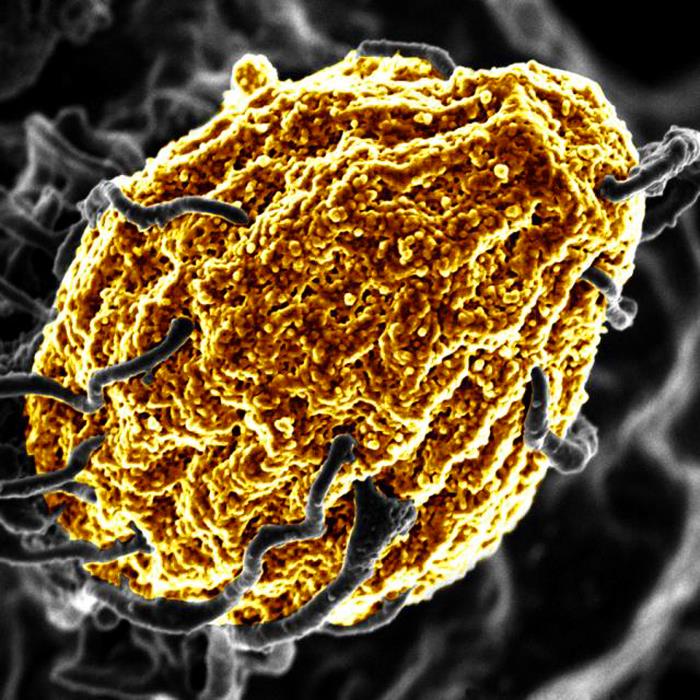Analysis: Landmark SA Court Case Takes on US Maker of Cystic Fibrosis Drugs

By Catherine Tomlinson
Cystic fibrosis (CF), which is caused by a faulty gene inherited from one’s parents, is a debilitating disease requiring difficult and time-consuming treatment and resulting in premature death. CF causes mucus in the body to thicken, with often disastrous consequences in organs such as the lungs and pancreas, and triggers a range of symptoms in people living with the condition, including chronic coughing, wheezing, and malnutrition. Ongoing treatment of symptoms often requires children with CF to miss school and can make it difficult for adults with CF to hold steady employment.
Yet, a new class of medicines introduced over the past decade called CFTR modulator therapies offers new hope to people living with CF – dramatically reducing CF’s symptoms and allowing people with CF to live longer healthier, and more productive lives.
These new treatments, whose research and development benefited from significant public and philanthropic financing, have been hailed as a “miracle” for people with CF. As antiretrovirals did for HIV, the introduction of CFTR modulator therapies is transforming cystic fibrosis from a progressive, life-threatening illness into a chronic, manageable condition. CFTR modulator therapies are so effective because they address the underlying cause of cystic fibrosis symptoms – a malfunctioning protein made by the CFTR gene.
But, more than a decade after the introduction of the first CFTR modulator therapy to treat CF in the United States, no CFTR modulator therapies are yet registered in South Africa and only a fraction of patients who need this therapy have access to it, and that is only after jumping through some extraordinary hoops. As a result, the only way for the vast majority of people to manage CF in South Africa is to aggressively prevent and treat its symptoms using older therapies. This is no small task for patients and their families, as it can require time-consuming, daily physical therapy to loosen mucus in the lungs and weeks-long hospital stays to treat infections. In severe cases, treating cystic fibrosis can even require a lung transplant.
Without access to CFTR modulator therapies, people with CF in South Africa continue to die prematurely. The average age of death of people with CF in South Africa was 27.5 in 2020. People in the global North live almost twice as long. The life expectancy of people living with cystic fibrosis in the United States is now 50 and is expected to lengthen as a result of newly introduced treatments.
Why can’t people in South Africa access CFTR modulator therapies?
As a person living with cystic fibrosis, or the parent of a child with cystic fibrosis, it can be unbearable to know there is a medicine that could allow you to breathe easier, keep you or your child out of hospital, and even prevent the need for a lung-transplant or premature death, but that you can’t have it, largely due to decisions taken by one company.
As recently detailed in the New York Times, one company holds a monopoly on the manufacture and sale of CFTR modulator therapies and is choosing not to make new CF treatments available to people in the developing world through the normal channels. Vertex, the company that holds monopoly patents on all available CFTR modulator therapies, is – for the most part – not registering or marketing its CFTR modulator therapies in developing countries. Registration is typically required before a drug can be marketed in a country.
While Vertex does offer some compassionate use and donation access programmes in select developing countries, Vertex Save Us, a global coalitional of advocates seeking affordable and universal access to CFTR modulator therapies, says these efforts reach only a small minority of patients that could benefit from the treatments and are restricted to countries with which Vertex believes it can secure a reimbursement deal.
Some activists suggest that the neglect of patients in developing countries is part of a strategy to squeeze the highest possible prices for CFTR modulator therapies from health systems in wealthy countries, with which Vertex has been locked in extended negotiations. Offering lower prices to developing countries for its CF medicines could provide ammunition to wealthy countries in demanding lower prices.
“This is a really fundamental and really simple example of how unfettered profit-driven business practices basically sacrifice the lives of people, particularly those of people who happen to live in low- and middle-income countries,” says Diarmaid McDonald, medicine access advocate and Director of the UK-based advocacy group, Just Treatment.
Vertex charges over R5 million ($322 000) annually for its most effective CFTR therapy, Trikafta (which must be taken as a life-long treatment) in the United States. But researchers in the United Kingdom have shown that the medicine can be manufactured and profitably marketed at a fraction of that cost.
Does Vertex plan to register its products in South Africa?
In response to queries from Spotlight regarding whether Vertex plans to register its drugs in South Africa and what the timeline for doing this is, the company indicated that they did not plan to register their medicines but would supply them via Section 21 authorisations – a mechanism allowing for importation of unregistered medicines into the country.
“As seen in other rare disease areas, bringing medicines to patients in South Africa is challenging as the reimbursement system and willingness to invest do not support a viable path to sustainable access. Analyses show that most novel, high-value medicines targeting disease areas comparable to and including CF are not on the Prescribed Minimum Benefits (PBM) list. There is therefore no obligation for funders to reimburse the costs of these medicines even after a lengthy regulatory registration process,” said Vertex’s Director of International Communications Daria Munsel.
“Given this, we believe that sustainable access could be achieved through ‘Section 21’ (on a named patient basis), which provides the fastest and most efficient route to access for rare disease medicines in South Africa,” Munsel added. “As part of this effort, we are currently in discussions with relevant stakeholders in the private insurance system to ensure sustainable access is available to eligible CF patients in South Africa.”
However, Munsel declined to identify the local company with which Vertex has signed an agreement for distributing its medicines, saying, “We can confirm that we have recently signed a distribution contract with a local distribution partner for our CF medicine in South Africa. Given that reimbursement conversations are still ongoing, it is inappropriate for us to name other parties for the moment.”
For now, the lack of transparency about the local distributor effectively blocks the use of Section 21 authorisations for importing Vertex’s medicines into South Africa, as patients and clinicians must supply details of local distributors in their applications to the South African Health Products Regulatory Authority (SAHPRA) for authorisation to import unregistered drugs.
Vertex did not respond to a question from Spotlight regarding what price it would charge patients in South Africa able to secure Section 21 authorisations to import their medicines.
Landmark court case seeks to challenge Vertex’s monopoly in South Africa
Vertex has secured a global monopoly over CFTR modulator therapies by aggressively pursuing patents related to the class of drugs around the world. These patents prevent other companies from manufacturing and marketing CFTR modulator therapies and give Vertex wide latitude in setting prices.
Between 2007 and 2016, Vertex filed six patents in South Africa related to the CFTR modulator therapies, Kalydeco and Trikafta. While Vertex received marketing approval to sell Kalydeco and Trikafta to treat CF in the United States in 2012 and 2019, respectively – it has still not applied for registration of either product in South Africa.
What this means is that despite Vertex’s failure to take steps to register or market its medicines in South Africa years after doing so in the US, patents granted to Vertex in South Africa block any other companies from supplying the medicines to CF patients in the country.
“The bottom line is that people are dying, they need to be able to access affordable treatments,” says Kelly du Plessis, founder of Rare Diseases South Africa. “If Vertex isn’t going to be able to come to the party in South Africa, then fine. We respect their choice, but then move out the way and allow someone else to do it. You can’t maintain the market and hold it ransom, but also not do anything from your perspective to help.”
According to Fatima Hassan, director of the Health Justice Initiative, “You can’t have a system where you file your patents, [but then] you refuse to bring a product to market or you have it at such an excessive price in the country with the highest inequality in the world, but then you don’t allow any generic manufacturers to come in at a lower price.”
Cheri Nel, a woman living with cystic fibrosis in South Africa, and the Cystic Fibrosis Association have now gone to court to challenge Vertex’s monopoly. On 7 February 2023, Nel’s lawyers submitted a Notice of Motion to the Court of the Commissioner of Patents (within the High Court) requesting that the court grants a compulsory license to override Vertex’s patents on Kalydeco and Trikafta.
Nel and the Cystic Fibrosis Association are seeking a compulsory license on the grounds that the patents held by Vertex are being abused. Nel’s lawyers argue that by failing to register or supply their CF medicines in South Africa, make them available in South Africa at reasonable prices, or license other companies to supply the medicines, Vertex is abusing its patents. They further argue that Vertex’s actions are violating the Constitutional rights of people with cystic fibrosis in South Africa, including the right to health care.
If granted, a compulsory license in South Africa would effectively override Vertex’s monopoly and allow the importation of generic cystic fibrosis medicines into South Africa, as well as their manufacturing in the country.
The legal action taken in South Africa is being pursued simultaneously with broader global efforts, led by Vertex Save Us, to overcome Vertex’s monopoly on CFTR modulator therapies and ensure universal access for all people who can benefit from these treatments.
“South Africa is the only country where papers have been launched with courts to start a legal process to try and secure a compulsory license, although the process is playing out in other countries following the most logical, legal routes set out in their national law,” explains McDonald.
“Requests of the government to issue compulsory licenses [have been made] in both Ukraine and in Brazil. And in India, it’s a petition of the government requesting that they revoke the patent under the terms of the Indian patent law,” says McDonald.
Any precedent for granting compulsory license on a medicine in South Africa?
If Nel and the Cystic Fibrosis Association’s pursuit of a compulsory license on the cystic fibrosis medicines is ultimately successful, then the issuing of a compulsory license order will be the first time this type of license is granted in the country on a pharmaceutical product. While South Africa has not issued a compulsory license on a medicine, the Treatment Action Campaign (TAC) has previously used competition law to overcome patents impeding access to affordable antiretroviral medicines in South Africa.
TAC cases at the Competition Commission and the threat of ‘compulsory licensing’ resulting from these cases led several multinational companies to grant voluntary licenses that enabled manufacturing and marketing of generic ARVs in the country. Generic competition resulted in massive price decreases for ARVs and has been critical to South Africa’s success in building the world’s largest public sector HIV treatment programme.
While South Africa’s courts have not issued a compulsory license on a medicine, its own challenges in securing access to affordable HIV medicines contributed to the affirmation and strengthening of the rights of countries to issue compulsory licenses to address health challenges within international trade law in the early 2000s. Both developing and developed countries have subsequently used compulsory licensing to improve access to critical health tools under patent including for HIV, cancer, and more recently, COVID-19.
The Fix the Patent Laws coalition, a coalition of over forty patient groups in South Africa, has long called on government to amend South Africa’s patent laws to improve the usability of compulsory licensing provisions to address health challenges in the country. The landmark court case of Nel vs Vertex will provide important insight into the ongoing need for these reforms in the country.
Who can benefit from Kalydeco and Trikafta
While cystic fibrosis is caused by a defect of the CFTR gene, over a thousand different types of mutations can occur in the gene that causes CF. People with CF must inherit a mutated gene from each parent in order to develop CF illness. The type of gene mutations that each person with cystic fibrosis inherits from their parents determines their eligibility for different CFTR modulator therapies.
Vertex, which has a monopoly over the entire class of CFTR modulator therapies available for CF, currently markets six medicines made up of different combinations of active ingredients that seek to correct the faulty CFTR protein (produced by the CFTR gene).
Kalydeco, made with the active ingredient ivacaftor, was the first CFTR modulator therapy approved to treat CF, yet it is only effective in treating five percent of people living with CF. Trikafta, which was approved in the U.S. in 2019 and combines three active ingredients – elexacaftor, tezacaftor and ivacaftor – is effective in treating 90 percent of people living with cystic fibrosis.
How many people in South Africa could benefit from Trikafta?
The recently established South African Cystic Fibrosis Registry has compiled health and demographic data for 525 people diagnosed with cystic fibrosis in the country. According to 2020 registry data, 450 patients (85.7%) would benefit from currently available CFTR modulator treatments. Dr Marco Zampoli, paediatric pulmonologist at the University of Cape Town, estimates that around 35 patients are currently sourcing generic CFTR modulators in their personal capacity from overseas (see more below on how a small group of patients in the country are accessing treatment from Argentina).
While the registry counts 525 patients diagnosed with CF in South Africa, the true number of people born with CF in the country is likely far higher. Zampoli estimates (using population and genetic data) that between two and three thousand babies could have been born with cystic fibrosis in South Africa since 1999.
“We think a lot of them are probably dying from a very young age without being diagnosed with cystic fibrosis as it looks similar to other common things like malnutrition, TB, and HIV,” says Zampoli.
While improving CF detection and diagnosis can save lives and will also increase the number of known patients in the country that could benefit from currently available CFTR modulator therapies, many of the new patients identified from better detection efforts would be unable to benefit from existing treatments. This is because black Africans are less likely than people of Caucasian descent to have the mutations that are responsive to currently available treatment.
Zampoli, however, notes that research is underway that will likely deliver new treatments that benefit patients who are ineligible for currently available drugs and adds “we’re going to be facing the same issues [of unaffordability] down the line… when we do eventually license a drug that will target their specific genes.”
How do a few people in South Africa get access to CFTR modulators?
While the South African government is not currently in negotiations with Vertex, price negotiations with health systems in wealthy countries have often dragged on for years, as price remained a sticking point.
People living with severe cystic fibrosis, however, do not have years to wait as their disease advances, placing them at risk of severe complications and death. Some have joined together to start a CF Buyers Club. The Buyer’s Club supports CF patients from around the world in buying generic versions of CFTR modulators from Argentina.
Argentina has taken steps to set strict criteria for granting patents and limit the granting of patents on certain types of claims related to pharmaceutical products. As a result, Vertex has not been granted patents on its CFTR modulator treatments in Argentina, and two Argentinian pharmaceutical companies, Gador and Tuteur, are legally manufacturing generic versions of these medicines.
While the Argentinian companies producing these medicines are unwilling to export them to South Africa for fear of facing patent infringement challenges from Vertex, Argentinian pharmacies will supply medicines to CF patients from South Africa visiting Argentina.
“You need to have a doctor’s script and you need to have a Section 21 authorisation,” explains Belinda Nell, a South African advocate working to facilitate access to CF medicines in South Africa. “You’ve got to fly to Argentina in your personal capacity or have a family representative go there and collect [the medicines] and then fly back.”
South Africans holding Section 21 authorisations from SAHPRA can legally travel with up to six months’ medicine supply on them.
While the CF Buyers Club provides an important access pathway enabling some people in South Africa to access life-saving CFTR modulator therapies, this pathway is not a feasible mechanism to ensure access to the CF medicines for all patients that could benefit from them.
The cost of generic CF medicines from Argentina is a fraction of the prices charged by Vertex. They are, however, still prohibitively high for most people living in South Africa. The annual cost of generic Trikafta from Argentina is almost R1 million ($60 000) [other CFTR modulator therapies (tezacaftor/ivacaftor and lumacaftor/ivacaftor) can be bought from Argentina for around R245 000 ($15 000) annually]. The medicine costs, combined with the costs of biannual travel to Argentina, are simply unaffordable for most.
How can a CL further reduce prices?
As seen with other classes of drugs, such as antiretroviral medicines for HIV, and antiviral medicines for Hepatitis C, the introduction of generic competition is expected to substantially reduce the cost of CF medicines.
If compulsory licenses are granted in the countries that they are being sought by Vertex Save Us, or if Vertex buckles under the pressure for expanded and affordable access to CF medicines and grants voluntary licenses allowing other companies to produce generics, then prices are expected to fall.
An analysis of the costs of production of CF medicines produced by health economists shows that generic Trikafta can be manufactured and sold with a 10 percent profit margin for around R93 000 ($5700) per patient per year – 2% of what is charged for the medicine by Vertex in the United States. While supplying medicines at this price would remain a stretch for South Africa’s public health sector, the introduction of new CF medicines must be considered within the context of potential cost savings arising from reduced hospitalisation periods and fewer transplants.
“The ripple effects of an effective CL campaign and petition in South Africa would be felt globally,” says McDonald. “First of all, I think we would see increased interest from generic suppliers… that could help to… drive down prices… this would [also] show the rest of the world that… accepting the unquestioned, monopoly power of Vertex is not necessary – you can put the lives of your citizens over the profits of that drug company.”
Note: The Fix the Patent Laws coalition and the TAC are mentioned in this article. Tomlinson worked at the TAC until 2012 and was a member of the Fix the Patent Laws steering committee until 2019. SECTION27 has also applied to be admitted as amici curiae to the case. Spotlight is published by SECTION27 and the TAC, but is editorially independent – an independence that the editors guard jealously. Spotlight is a member of the South African Press Council.
Republished from Spotlight under a Creative Commons 4.0 Licence.
Source: Spotlight











